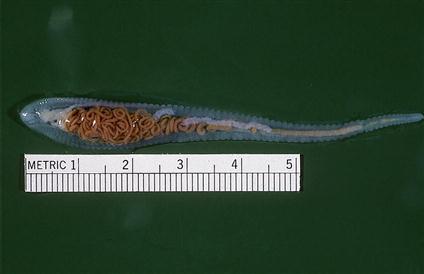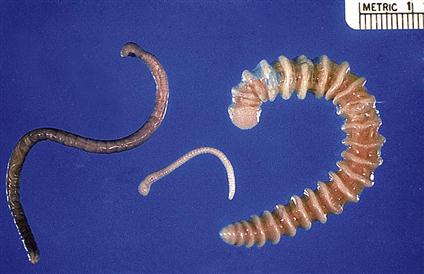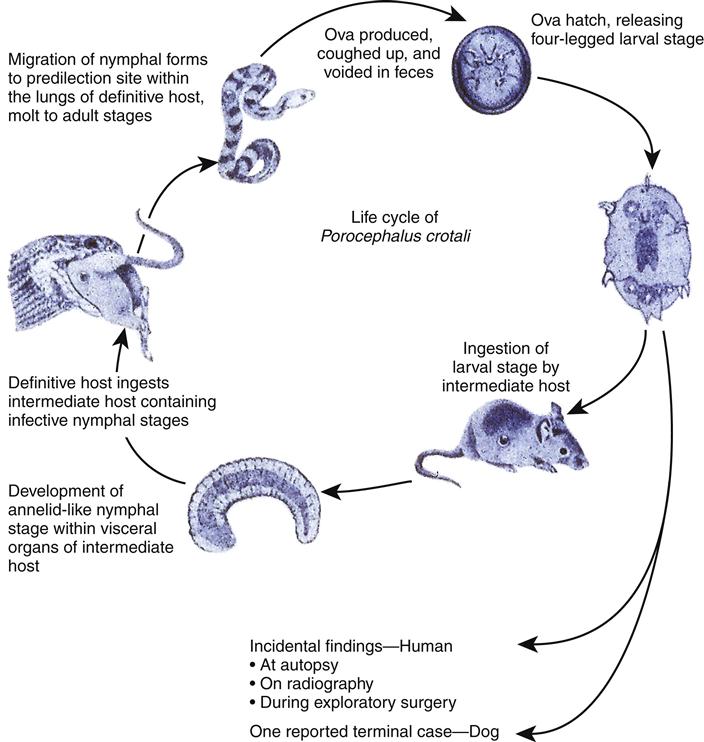Introduction to the Phylum Arthropoda, Subphylum Pentastomida
Learning Objectives
After studying this chapter, the reader should be able to do the following:
Key Terms
Pleomorphic
Larval stage of pentastome
Nymphal pentastome
Tongue worms
Linguatulids
Pentastomiasis
Linguatulosis
Linguatuliasis
Pentastomes (Parasites of Reptiles)
Reptiles have served as hosts to protozoan and metazoan parasites for eons. One of the oldest continuing host-parasite relationships is that between snakes and pentastomes. Pentastomes are almost exclusively parasites of the reptilian respiratory system. According to theory, the pentastomes’ ancestors were once land animals that invaded the respiratory passages of reptiles. These rare parasites hold serious zoonotic consequences for humans, who can unwittingly serve as incidental hosts.
Pentastomes have lost most of their morphologic similarity to other major phyla; they are a taxonomist’s dilemma. During their life cycle, pentastomes are pleomorphic (demonstrating a variety of morphologic forms). They resemble acarines (mites) during their larval stage, but look like annelids (earthworms) during their nymphal and adult stages. It is difficult to assign them to either phylum, which probably means that they possess a common ancestor with annelids and arthropods. Therefore these creatures have been assigned to the subphylum Pentastomida.
Morphology
The name pentastome (penta meaning “five” and stome meaning “mouth,” thus five mouths) was chosen because these parasites, as adults, have a mouth on the anterior end that is surrounded by four hooked claws. Early investigators erroneously believed these claws to be four additional mouths; “one mouth” plus “four mouths” equals “five mouths.” Pentastomes have also been called tongue worms and linguatulids because of their distinct tongue-shaped appearance, being wider anteriorly than posteriorly (Figure 14-1). Infection with pentastomes is referred to as pentastomiasis, linguatuliasis, linguatulosis, or rarely, porocephalosis or porocephaliasis (after Porocephalida, one of two orders composing the subphylum Pentastomida).
Grossly, pentastomes resemble helminths; however, they are often grouped with the phylum Arthropoda because of the mitelike larval stage that appears during their life cycle.
Pentastomes are almost always parasites of reptiles; the exceptions to this rule are species of Linguatula serrata (which parasitize carnivores) and Reighardia sternae (a parasite of seagulls and terns). Within the phylum are nine genera that parasitize snakes, three that parasitize lizards, four that parasitize crocodiles, and two that favor turtles. Among snakes, the most common genera are Armillifer species that parasitize pythons and vipers, Kiricephalus that parasitize cobras, and Porocephalus that parasitize boas and rattlesnakes (Figure 14-2).
Life Cycle
Adult reptilian pentastomes are dioecious parasites; they have separate sexes, and there are both male and female pentastomes. Pentastomes are parasites that occur almost exclusively within the lungs, trachea, and nasal passages of the reptilian definitive host, feeding on tissue fluids and blood cells. Female pentastomes produce several million fully embryonated eggs, each containing a single larva with two or three pairs of rudimentary clawed legs. Eggs are “coughed up,” swallowed, and passed to the outside environment within the host feces. Oval, tailed larvae with four to six stumpy legs, each with one or two retractable, pincerlike claws, hatch from the eggs and are infective for the intermediate host. Figure 14-3 shows the life cycle of a reptilian pentastome.
Stay updated, free articles. Join our Telegram channel

Full access? Get Clinical Tree





